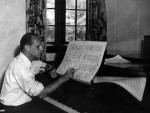Title
As evidenced by a recent article in The New York Times and performances at The Juilliard School, there is renewed interest in the life and music of William Schuman. This revival is largely the result of the scholarly work and promotion of Juilliard’s own president, Joseph W. Polisi, who shared his expert knowledge of Schuman at the final doctoral forum of the academic year on March 30. Specifically, his lecture centered on the genesis and metamorphoses of Schuman’s Violin Concerto, a centerpiece of the Juilliard Orchestra program on April 1 in Avery Fisher Hall.
Body
In a recent interview, Polisi told The Journal that Schuman became a “mentor and friend” when Polisi became president in 1984. After Schuman’s death in 1992, Polisi started work on a biography of Schuman (American Muse: Life and Times of William Schuman, Amadeus Press, 2008) and consequently began to digest and love his music. Polisi’s reason for focusing on the Violin Concerto now is not only because it is a “spectacular piece that should be known better,” but also because it “was probably his most revised composition.” Polisi unearthed the history of the work’s revision by examining Schuman’s letters and oral histories, as well as manuscripts and audio recordings of performances of the concerto. His lecture was accompanied by numerous musical examples, both audio and visual, which greatly illuminated Schuman’s revision process.
With a total gestation of 14 years, the compositional process of the work was uniquely lengthy for Schuman, who did not usually revise his works to that extent because of his busy life as an arts administrator and composer. The concerto, commissioned in 1946 (when Schuman was the president of Juilliard), has been performed in three versions—1950, 1956, and 1959—culminating in the 1960 publication. In the lecture, Polisi partially attributed this “rare compositional introspection” to the enormous compositional growth and evolution that Schuman experienced during this time period, as his approach moved “from diatonic to chromatic textures and complex rhythmic and harmonic juxtapositions, which make his works edgier.” Considering the work in relation to the composer’s output during this time period, he explained, “provide[s] an intriguing look into the mind of Schuman as he composed this most affecting work.”
The concerto was commissioned by violinist Samuel Dushkin, who hoped to premiere it with Serge Koussevitzky and the Boston Symphony Orchestra. Schuman finished the piece in 1947 and sent the score to Koussevitzky. Despite his affinity for and interest in the concerto, Koussevitzky refused to perform the piece with Dushkin, whose playing was not up to the conductor’s standards. Because Dushkin had paid for the work and held exclusive rights to the concerto for three years, the premiere did not occur until 1950 with Isaac Stern as soloist and conductor Charles Munch with the Boston Symphony.
After the premiere, Schuman was unhappy with the second movement, Part II, and decided to rewrite it. He felt there was too much contrast between this soulful, lyrical, and languorous movement and the rest of the work. Instead, to focus the concerto’s intensity and passion, Schuman deleted the movement and altered the overall structure of the concerto, creating a two-part, rather than three-movement work. (Interestingly, the deletion of Part II was not the death of the movement: at the suggestion of Christopher Rouse, the discarded movement became the foundation for a later work,Three Colloquies for French Horn and Orchestra (1980). In the third movement, “Remembrances,” Schuman uses a chromaticized and dissonant version of the original violin melody.)
In place of the beautiful, melodious movement, Schuman inserted sections of orchestral pronouncements juxtaposed with solo violin lines. As the music intensifies, the violin breaks into a skittish, improvisatory quasi-cadenza section, which then leads into the 1950 version’s Part III. Though there were other alterations as well, this change of the work’s fundamental structure is the most obvious modification of the 1950 version. The revised work was presented in a 1956 performance with Isaac Stern as soloist with the Juilliard Orchestra and conductor Jean Morel.
Yet again, Schuman decided more adjustments were necessary, and he continued to delete sections, as well a make articulation, dynamic, orchestration, rhythmic, and melodic changes in both Parts I and II of the concerto. The third and final version of the work was introduced in a 1959 performance at the Aspen Music Festival with Roman Totenberg as soloist and Izler Solomon conducting.
That version of the concerto, along with its original stand-alone Part II, was performed on April 1 by soloist Francisco Ladron de Guevara Finck and the Juilliard Orchestra under the baton of Maestro Leonard Slatkin. The all-Schuman concert, an addendum to the Focus! 2010 festival, “Music at the Center: Composing an American Mainstream,” was a celebration of the centennial of the composer’s birth.
Because Schuman’s own references to the concerto revisions are “nonspecific,” Polisi looks to the “unique circumstances of the work’s evolution” for an explanation. First, he cites the delay between the work’s completion and premiere, as “Schuman was forced to put the work aside and develop new compositions.” Also, as traced in works of that time, the late 1940s and ’50s brought drastic changes to his compositional style, “from the extroverted, tonally-direct” to the “more dissonant and chromatically-inflected.”
Ultimately, Polisi explained, “Schuman was a young composer who moved to middle age during the gestation of this work.” His continual distillation of the concerto created a work of “pathos, passion, and drive that showcases the virtuosic and expressive qualities of the solo instrument,” and his detailed editing provided “a focus and passion that merits consideration of the Violin Concerto as one of his most successful and masterfully composed works and one of the finest violin concertos of the 20th century.”





